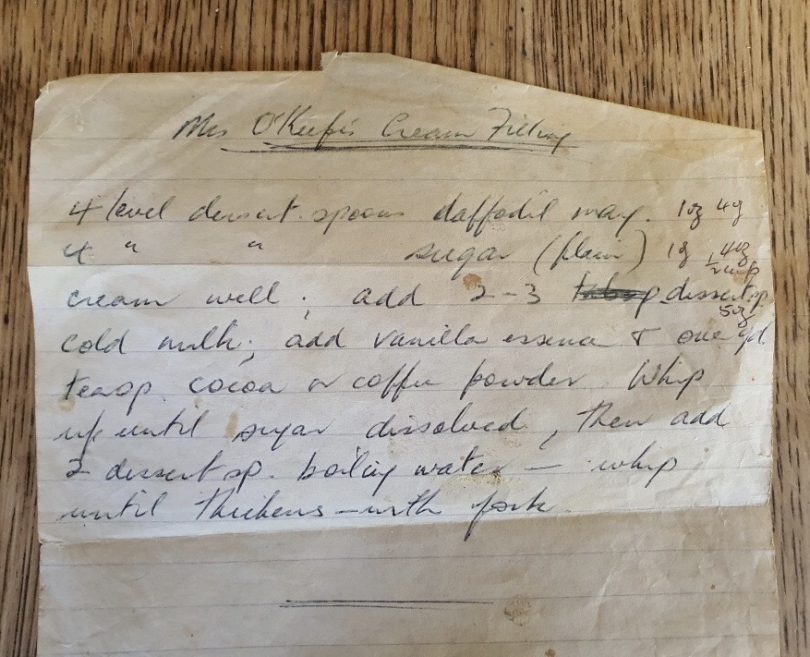
The sometimes turn and tattered cookbooks that have pride of place in the Jacobs kitchen. Photo: David Jacobs.
Do you have a cookbook shelf in your kitchen? What’s the most stained, dog-eared volume you own?
It’s a fair bet that a Women’s Weekly publication features somewhere, from the well-loved cakes and biscuits tome to the revered birthday cake book. And unlike pretty much anything else in your house except small children, the degree of grubbiness is a good indicator of usefulness, respect and love.
As a journalist, I’ve been the recipient of many a cookbook in the mail over the years. They’re glossy shiny things full of everything from how to make a jellied bubble of foaming olive essence (why?) to cooking traditional tripe a la mode.
The books look lovely, the photos are glorious and I’ve devoured them like a racy novel.
But I don’t cook from them because that requires trust, a shared vision, a commitment of faith. And often, a lot of butter.
As someone who’s spent much of my adult life on a farm 2o km from town, I resent wasting what’s in the fridge unless I know the result is worth it.
Instead, I turn to the half dozen books stacked on top of the fridge in permanent use.
Pride of place goes to Stephanie Alexander’s Cooks’ Companion. Not the stripy covered one, the original orange version. Its spine is cracked irreparably, there are brown smudges and rings on the cover and oil spatters on the pages. My late mother-in-law gave it to me 23 years ago.
Stephanie is no poet, but she knows her stuff and her recipes are clear and direct, from how to roast a medium-rare beef fillet to a fail-safe self-saucing chocolate pudding (my tip, replace the milk with orange juice). There’s a touch of whimsy too – “marmalade from a competent Western District Cook” has been my go-to for many years when I fire up the jam pot.
Neil Perry’s Balance and Harmony: Asian Food comes next, not quite so tatty as Stephanie, but filled with recipes ranging from easy to adventurous, all clearly described and completely reliable.
From a straightforward beef and asparagus stir fry to the perfect ginger poached chicken, Neil tells you how to get there. And when I interviewed him years ago, he graciously sorted out why my radio producer’s fried rice wasn’t working (use rice you’ve cooked the day before to keep it dry and light).
I’ve flirted with Nigella over the years but there was a regrettable incident one Christmas with a Cointreau-flavoured trifle so heavy on the liqueur that I lunged to stop my four-year-old nephew from imbibing.
While I like her ideas, it sometimes seems that Nigella is so besotted by the voluptuous image she’s creating that actual, practical directions can be a bit lacking.
I enjoy Jamie Oliver’s straightforward recipes but realise that I just don’t use them anymore. Margaret Fulton has somehow never done it for me. Maybe it’s the era but her recipes seem so – obvious? Unexciting?
But British television gardener Monty Don has written a couple of lovely books over the years about his Herefordshire garden, his vegetables and fruit.
I love growing my own, and both Fork to Fork and The Home Cookbook are full of useful ideas for plain, delicious family food.
Jane Grigson’s fruit and vegetable books are tattered paperbacks and Elizabeth David’s Italian Food was probably the first cookbook I bought as a university student, keen to impress my then-boyfriend with a seafood risotto.

A treasured handwritten recipe for cake fillings. Photo: David Jacobs.
Then there are the school fundraising, footy club cookbooks, and the folder of cuttings that includes Grandma Katie’s coffee sponge, Mrs Stanyer’s pavlova and Mrs O’Keefe’s slightly tricky but delicious cream filling for cakes. Mrs O’Keefe was our long-time next-door neighbour and I wangled the recipe in return for taking her to medical appointments in Wagga.
These are the recipes I love most. I’ve never succeeded with my grandmother’s sponge “peaches”, requiring gem irons, cochineal colouring and cream filling, but the recipe in her elegant clear hand is a treasured possession. And while my mother didn’t write out in her own hand the pikelet recipe that was famed across the district, I do have the skillet she turned them out on by the hundreds.
What books and recipes do you turn to over and over again? What are your trusted sources for the food you and your family love?
Mrs O’Keeffe’s cream filling, a light alternative to cream for sandwiching a sponge cake.
4 level dessertspoons margarine
4 dessertspoons caster sugar
2 dessertspoons milk
Vanilla essence, or one tsp cocoa powder or coffee powder
2 dessertspoons hot water
Cream the margarine and sugar with a fork and beat in the milk and vanilla essence or flavourings until they combine. Boil the kettle and whip in the hot water, beating continuously until mixture is light and glossy.
This is essentially an emulsion, like homemade mayonnaise, so you’ll need to whip constantly to bring it together. And sometimes it just won’t work at all, but the beauty of it is that you won’t waste much.
Original Article published by Genevieve Jacobs on The RiotACT.









